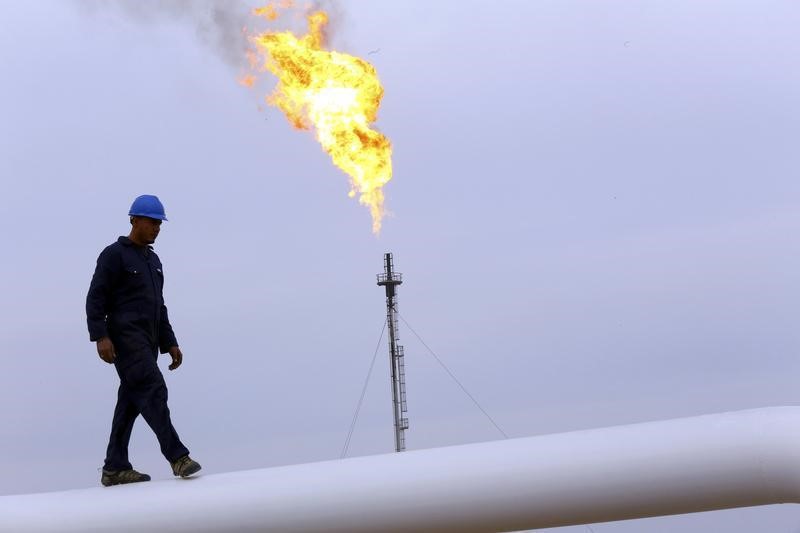By Barani Krishnan
Investing.com - The U.S. crude inventory build isn’t going away. In fact, it’s growing. But that didn't deter crude bulls who bought back much of the market’s plunge on Wednesday after a mega crude build reported by the U.S. government.
Oil prices settled the day just slightly in the red, recovering from a 2% plunge after the Energy Information Administration, or EIA, reported that stockpiles of U.S. crude jumped by a little over 16 million barrels last week in the fourth largest build ever.
New York-traded West Texas Intermediate, or WTI, crude for March settled down just 47 cents, or 0.6%, at $78.59 per barrel, rebounding from a session low of $77.28.
“Crude prices are under pressure” but “WTI crude might not break here,” said Ed Moya, analyst at online trading platform OANDA. “Energy traders may continue to buy on dips and the mid-$70s may still provide major support.”
London-traded Brent crude for March delivery was down even less, with a decline of 20 cents, or 0.2%, at $85.38. The intraday bottom for Brent was $83.91.
In oil bulls corner was longer-term demand for crude predicted by the Paris-based International Energy Agency. The so-called IEA raised its forecast for 2023 oil demand by 500,000 barrels per day to nearly 102M bpd. It also cautioned that producer alliance OPEC+ might try to squeeze output to keep crude prices supported.
Crude stockpiles rose by 16.283M barrels during the week ended Feb. 10, the Washington-based EIA, which serves as the statistical arm of the U.S. Energy Department, said in its Weekly Petroleum Status Report.
U.S. commercial crude inventories have grown by 50.75M barrels so far this year.
The climb came as most U.S. refineries entered seasonal maintenance that foresaw less processing of crude.
U.S. crude oil refinery inputs averaged 15.0M barrels per day, or bpd, during the week ended Feb. 10 — some 383,000 bpd less than the previous week’s average, the EIA said.
Refineries operated at 86.5% of their operable capacity last week, the agency added. Typically, inventory runs at this time of the year are about 90% or more.
Last week’s crude build was the fourth-largest ever in the history of the EIA’s reporting, data showed. It was also the third largest in eight straight weeks of builds.
“That's a gigantic build,” analyst Adam Button said on the ForexLive platform, referring to the 16.3M barrels. “It's not entirely shocking as the API data late yesterday also showed a large build, but not that large.”
Trade group API, or the American Petroleum Institute, using its own count, on Tuesday reported a crude build of 10.507M barrels for the week to February 10.
Reuters, meanwhile, cited “unusually large crude oil supply adjustment” in EIA data that it said contributed to the outsized build.
"It's the worst kind of build that you can possibly have. It's all about the...adjustment number. There's no getting around that," said Bob Yawger, director of energy futures at Mizuho, in comments carried by Reuters.
Aside from crude, the EIA reported a build in stockpiles of gasoline while noting a dip in distillate inventories.
On the gasoline inventory side, the EIA reported a build of 2.317M, against a forecast rise of 1.542M and the prior week’s 5.008M. Gasoline inventories have gone up by more than 19M barrels since the start of the year. The automotive fuel is the primary U.S. fuel product.
The EIA said U.S. gasoline demand over the past four weeks fell 3.2% from a year ago, to 8.334M barrels per day.
Distillate stockpiles resumed their drop after rising last week for the first time in five weeks. Distillate inventories fell by 1.285M versus an expected build of 0.447M. In the previous week, distillate stocks rose by 2.932M.
Also weighing on oil earlier was the rally in the dollar, which slowed demand for oil and other commodities priced in the currency.
The Dollar Index, which measures the greenback against six other major currencies, hit a 10-month low of 100.68 on Feb. 2 but is now hovering near 104. The index rose after stickier-than-expected inflation data on Tuesday sparked worries that the Federal Reserve might turn aggressive again on U.S. interest rates just as the central bank seemed to be getting a little lax about monetary tightening.
